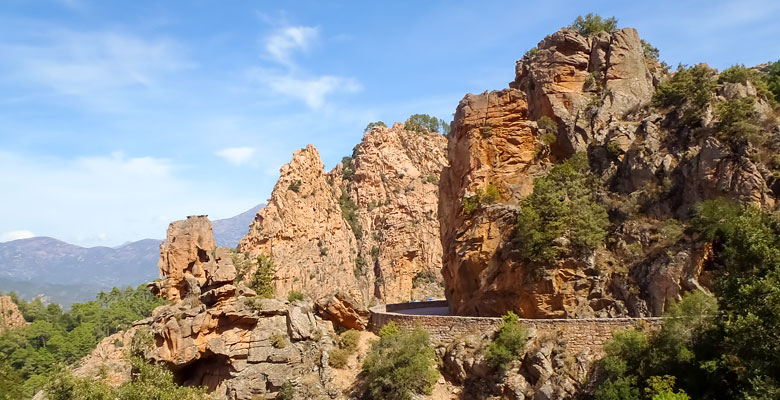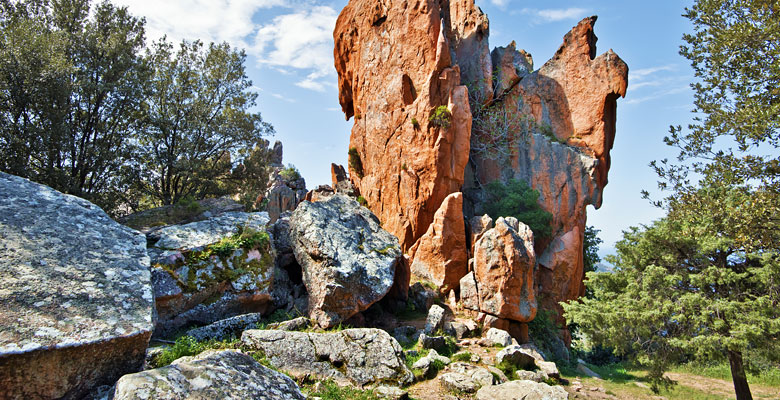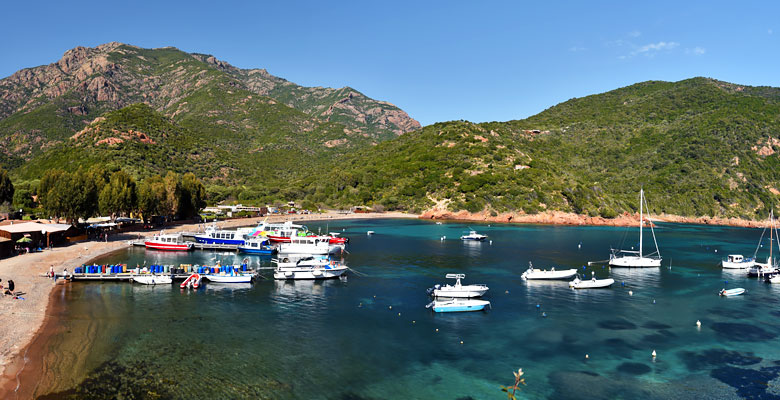UNESCO sites: Corsica
- By Heather Moore
- 10 Jul 2017
- What to do
Guest writer Heather Moore tackles one of the greatest drives in Europe along Corsica's
UNESCO-classified Calanques

"The best thing about Corsica is there are no museums and stuff," declared my ten-year-old, launching himself into the pool for the 40th time that day. Not strictly true of course; the island’s history is re-told at a scattering of modest museums in Ajaccio, Bastia, Corte and Aléria amongst others, and there are several very impressive prehistoric sites to wander round. However, there is nothing on the scale of Minoan Crete or Lycian Turkey say, or the countless cultural and artistic treasures of Tuscany and Umbria: all very good news for the child who can only be coaxed into any kind of cultural establishment on the outside chance of free wifi.
What Corsica does have however, is an extraordinary abundance of natural treasures. With sparkling rock pools for swimming or canyoning, dizzying mountain peaks, deep, dark gorges and beaches in every shade from blush pink to slate grey, the outdoor experience here is arguably the most intense in Europe. There is natural beauty at every turn, but perhaps the most unique is the Gulf of Porto, a UNESCO World Heritage protected nature reserve that incorporates the pink cliffs of the Calanques and the infinite blue of the Girolata Gulf.

Driving the Calanques de Piana
Snaking south from Porto to Piana in the north west of Corsica, the coast road through the Calanques is one of the most dramatic in Europe, an almost surreal landscape of wind-eroded granite cliffs that drop vertically into the deep indigo of the gulf. The cliffs are red, pink, russet and honey, carved into precipitous pinnacles by the elements and up to 300 metres above the sea in some places. You can do the drive in either direction: north to south puts the passenger on the cliff edge for the most exhilarating ride, though it’s not for the faint-hearted and I was very glad not to be the driver! We were advised to make an early start to avoid the busy afternoon period, but if you are travelling outside the main July-August period then sunset would be a fantastic time to see the cliffs in their spectacular evening colours. This stretch is barely 12km long, but you should allow at least an hour to drive it.

Exploring on foot
With typical enthusiasm for a potentially high-risk and therefore fun activity, my boys wanted to get out and climb the cliffs. With considerably more confidence than accuracy, I explained that the cliffs were UNESCO-protected and therefore that wasn’t possible (almost certainly not true, but I am claiming immunity under parental right to occasional white lies where necessary). So we settled for a walk, parking up below the Tête du Chien rock formation which is about half way along the road from Porto to Piana. The Dog’s Head rock does indeed look credibly canine, and from here we followed the path into the woods in search of another rock formation known as the Château Fort. The path dips down through the herby maquis and over a few rocks (flipflops are not helpful) before climbing quite steeply over more rocks out onto a plateau. The so-called Château Fort required a bit more imagination than our heat-befuddled heads were willing to offer, but the views over the gulf, the Calanques and Piana village more than compensated. We returned by the same route, with the whole thing taking less than an hour but decreed ‘worth it’ by all of us.

Gulf of Girolata: boat trips and beaches
The other way to really appreciate this awesome landscape and its sea caves is by boat trip, or at least it would be without excursion-adverse adolescent boys in tow. You can book a short tour from Porto or a longer day trip from Ajaccio, which removes the need to navigate the hair-pin bends and scary drops by car, and includes a two-hour stopover for lunch and swimming. Neither seemed to float our family boat however, so we compromised by taking the tortuous road and walking path down to the Marine de Ficajola near Piana for a swim and a snorkel beneath the cliffs. Not the best sand on the island, but a really dramatic spot on a day that was already bursting with scenic highlights. And having saved a good few euros by skipping the boat trip, we treated ourselves to dinner in Piana at the splendid Roches Rouges, a grand-but-faded hotel that has altered little in its 100-year history. The exceptional sunset views from the terrace made a fitting end to a day of superlatives: after all, who needs 'museums and stuff' when nature provides sights like these?"








